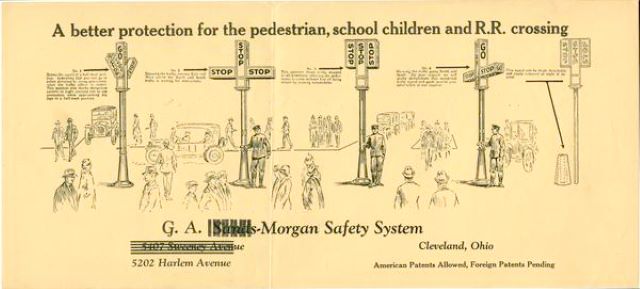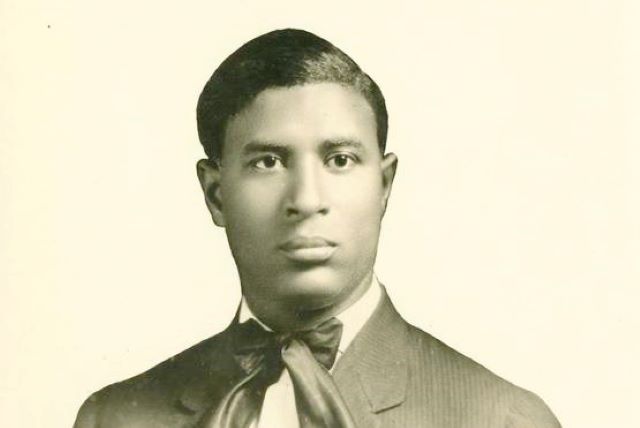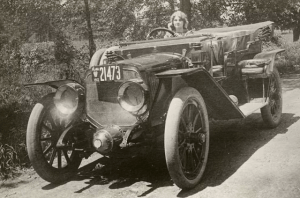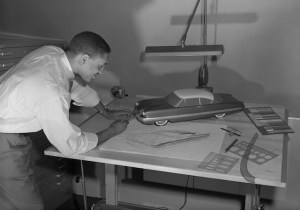Some things in life are so commonplace, we hardly give any thought to how they came to be. Such is the tale of the humble traffic light. You can trace the modern traffic light back to Cleveland, Ohio, and the son of two freed slaves. Armed with nothing more than an elementary school education and an innate curiosity of how things work, Garrett Morgan patented several inventions that would revolutionize society.
Morgan was born in Kentucky in 1877. While still a teenager, he left home and moved to Ohio in search of work. He first worked as a handyman in Cincinnati before landing in Cleveland.
Prefer an audio summary of this post? Click below to listen to this article.
At the turn of the 20th century, Cleveland’s garment industry was the second largest in the country. Morgan got a job sweeping floors at a garment factory. Enamored by the inner workings of the sewing machines, he taught himself how to fix them (they broke quite often). Eventually he was hired as a repairman before opening his own repair shop.
It was while working at his shop that Morgan serendipitously created his first major invention. He was experimenting with a chemical solution that prevented sewing machine needles from overheating and burning the fabric. As the story goes, Morgan wiped his hands down before going to lunch. When he returned, the hairs on the cloth were perfectly straight.
Morgan then tried the substance on a neighbor’s dog before testing it on himself. Each time, the same perfect results. Whatever oils were in the substance were able to break down and relax hair fibers. Morgan bottled up the substance and G.A. Morgan’s Hair Refiner was born. He sold it in African American communities around the country to great success.
With sudden financial security, Morgan was able to pursue other ventures. After watching firefighters struggle to breathe due to smoke inhalation, the inventor was struck with the idea of a safety hood. The device, which was patented in 1914, consisted of a hood placed over an individual’s head, connected to a long tube that reached the ground. Since hot air and smoke rise, the tube on the ground would deliver clean air to the person.
In 1916, the city of Cleveland was drilling a new tunnel under Lake Erie. Workers hit a pocket of natural gas, creating an explosion that trapped them underground. When Morgan heard what had happened, he and his brother donned the safety hoods and entered the tunnel themselves. They were able to save two lives.
Morgan’s safety hood is widely considered a precursor to the gas mask. With the onset of World War I – and the use of poisonous gas – Morgan won a contract with the U.S. Navy. The hood became standard equipment for the U.S. Army during the war.
Morgan’s successes allowed him to own an automobile, which was a rarity in the day (he was reportedly the first African American in Cleveland to have a car). Streets in America, though, were a mess in the early 1900s. With a combination of automobiles, carriages, bicycles and pedestrians, the roads were chaotic and navigating them was dangerous.
One day Morgan witnessed a terrible accident at a Cleveland intersection and his brain once again went into problem-solving mode. Traffic signals had been invented, but they only included “Stop” and “Go” alerts. The problem was that drivers didn’t know when the “Go” signal was going to switch to the “Stop” signal. The result was that drivers would stop abruptly or be stuck in the intersection when vehicles traveling in other directions began to move.
To solve this, Morgan invented a T-shaped traffic signal that had a third, “caution” signal. When this signal was on, traffic in all directions stopped and intersections would clear. It would also allow pedestrians to cross before traffic started moving again.

On November 20, 1923, Morgan was awarded a patent for a three-position traffic signal. In essence, he had invented the yellow light. Morgan’s original traffic signal prototype is on display at the Smithsonian’s American History Museum.
Aside from his technical contributions to society, Morgan was a pillar in Cleveland’s African American community. He founded the Cleveland Call, one of the most important African American newspapers in the country and was a leader in the city’s NAACP chapter.
Garrett Morgan passed away in 1963, one year before the passage of the of the Civil Rights Act.
For more stories about African American automotive pioneers, read about the fascinating lives of C.R. Patterson, Charlie Wiggins and Wendell Scott.
10 Thoughts on “Garrett Morgan: Inventor of the Three-Position Traffic Signal”
Leave A Comment
Comments are subject to moderation and may or may not be published at the editor’s discretion. Only comments that are relevant to the article and add value to the Your AAA community will be considered. Comments may be edited for clarity and length.

















can you tell me who is Garrett morgan.
He invented a type of traffic light. The original inventor was William Potts in 1920.
They didn’t specify that he created the traffic light.
The article stated Morgan was the “inventor of the three position traffic signal” which is not true. William Potts invented the 3 position 4-way traffic signal in 1920. Morgan patented a non 4 way version in 1923. Potts’ 3-way traffic signal was in use in an intersection in Detroit in 1920.
You must not like Black inventors? Because the article clearly states that “On November 20, 1923, Morgan was awarded a patent for a three-position traffic signal. In essence, he had invented the yellow light. Morgan’s original traffic signal prototype is on display at the Smithsonian’s American History Museum.” Why would you try to distract from his accomplishment?
Where is your proof Mr. Potts created the three-position traffic signal? In the Smithsonian?
Vaild
Real talk
Yes! Improved safety and traffic flow. Sarah Boone, born a slave, invented modern day ironing board. Great inventors who are unrecognized. I want my nephews to know each time they are at a traffic light or use the ironing board who gave us these two exceptional tools on which we depend to get us through daily living.
Where is your proof Potts DIDN’T? Potts years earlier had his ACTUAL 3 position electric LIGHTS (not hand cranked ARMS). Detroit had many of the four way lights in use years before Garretts mechanical version. You can easily look this up
We learn about all the big name inventors such as Thomas Edison, Marconi and Bell.
Inventors such as Garret Morgan invented things that we rely on in everyday life but they remain as hidden figures. Thanks for making this article available.